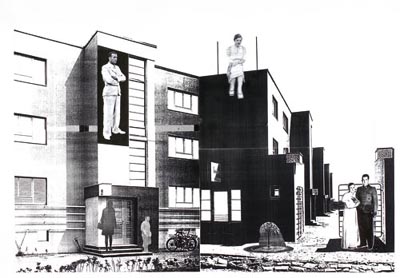 Silke Schatz Private Public In the third solo show at Wilkinson Gallery, Silke Schatz presents a personal portrait of the city Celle in Northern Germany, the town where she was born. It reveals two aspects of the town, private and public. Today the town appears as a tourist town with a castle and the typical wooden framework houses of the Lower Saxony area. In the show (which was first exhibited in the Kunstverein and Bomann-Museum in Celle, April 2006) Schatz presents works based on the architect Otto Haesler and an installation relating to her grandparents who lived in Celle. In the late 1920s until 1933 Otto Haesler, who was a pioneer of the "Neues Bauen"*, started building his suburban colonies such as the Siedlung Georgsgarten, 1927 as well as villas, such as "The Direktorenwohnhaus", 1931-32. In the early 1930's Walter Gropius asked him to become the director of the Bauhaus in Dessau, but he declined, because of his responsibilities in Celle. Schatz did not know until she began her research, that this architecture existed and it was a surprise for her to see his beautiful buildings, reduced in form, with colour as a simple method to underline the architecture. In this show, she has made models of two of his buildings. The first model, "Georgsgardenblock", is painted back to the buildings original colours after a lithograph from Karl Völkers. She has also added a wall mural in the style of 1970s naive painting. With the second model, "Direktorenwohnhaus", she has separated all parts of the structure by spray-painting them into a colourful design adding a ikea carpet together with stencils on the facade. Schatz has also made drawings of Haesler's buildings, making her own imaginary or idealistic additions. The private aspect of the project concerns Schatz's grandfather, who was a SS-officer, and lived in 1942 with his family in a building in Celle known to house SS Officers and their families, Thears** Gardenhouse. Her grandfather was a war criminal and after the war went on trial for an unsolved murder - he committed suicide in the early 1960's, her grandmother died shortly after him. "I never met my grandparents and just know them from stories from my family, I was interested in the family myth', because facing the fact that my grandfather was a war criminal is an open secret in the family nobody talks about. And the case about murdering a woman is a trauma in the family - the case never got solved". The installation "Wurzelkind"*** in the main gallery, includes puppets of her grandparents, Martha and Erich Schatz in front of a large drawing of the Thears Gardenhouse. The puppets stand around a lamp as if to keep warm (the lamp is a 1950's design "Lagerfeuer" (campfire) and was left in the building as it stood empty. * we have the term Neues Bauen, in german, which means all the architects, who started to built under the changed industrial circumstances in the1920s, the best known are the Bauhaus architects. ** Albrecht Daniel Thaer was an agricultural scientist in the 18th Century and invented the modern agriculture in Germany. *** Root Child - the title comes from an old children's book, from the late 19th century - which talks about the mother earth and the seasons of the year. Girls and boys appear as flowers and grass. Root child for me as well means the fact to go back to some of your roots-being radical, wanting to know everything, as well as going back onto your roots means becoming a child again. A catalogue published by Kunstverein and Bomann-Museum in Celle will be available in September 2006. Exhibition: 15 July - 13 August 2006 Gallery hours: Thu-Sat 11am - 6pm, Sun noon - 6pm, otherwise by appointment Wilkinson Gallery 242 Cambridge Heath Road, UK-London E2 9DA Telephone +44 020 8980 2662 Fax +44 020 8980 0028 Email info@wilkinsongallery.com www.wilkinsongallery.com |